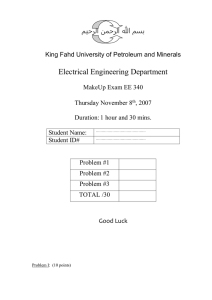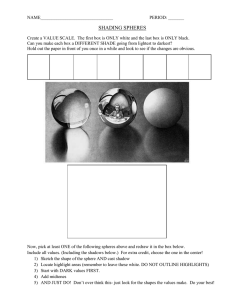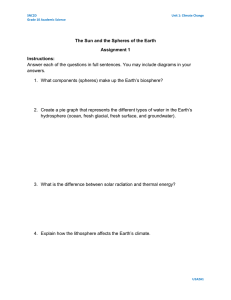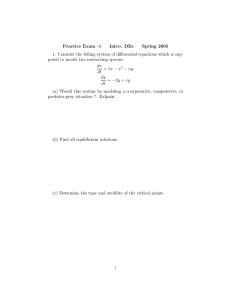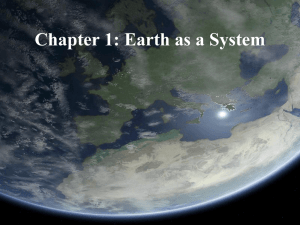Electric potential and field between two different spheres
advertisement
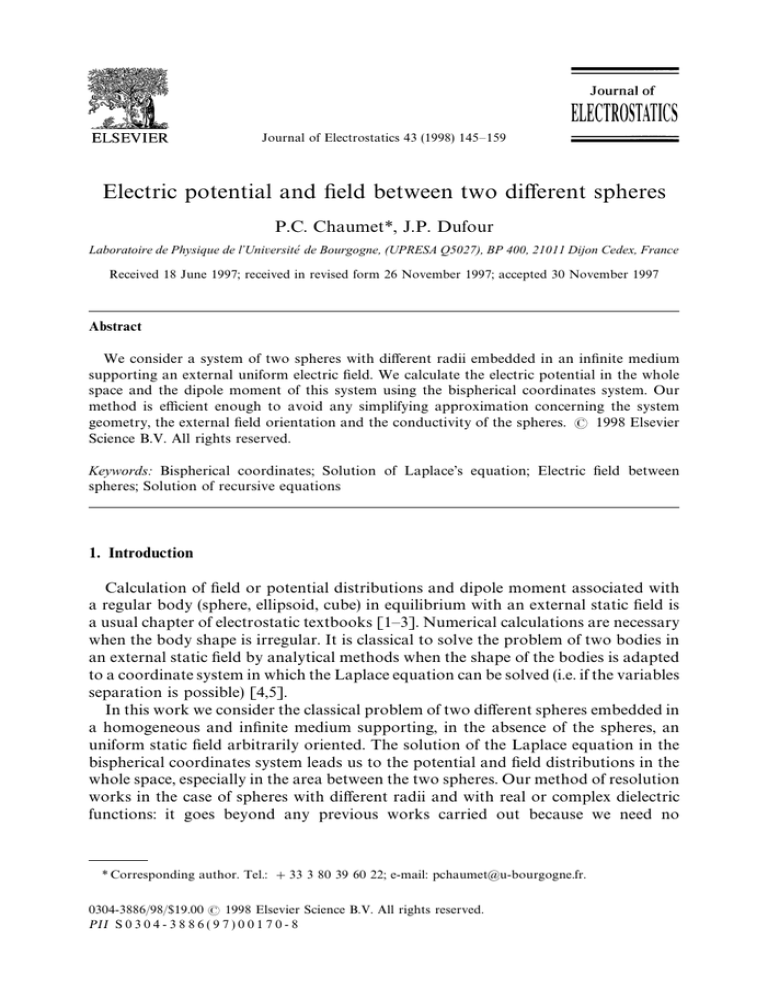
Journal of Electrostatics 43 (1998) 145—159
Electric potential and field between two different spheres
P.C. Chaumet*, J.P. Dufour
Laboratoire de Physique de l+Universite& de Bourgogne, (UPRESA Q5027), BP 400, 21011 Dijon Cedex, France
Received 18 June 1997; received in revised form 26 November 1997; accepted 30 November 1997
Abstract
We consider a system of two spheres with different radii embedded in an infinite medium
supporting an external uniform electric field. We calculate the electric potential in the whole
space and the dipole moment of this system using the bispherical coordinates system. Our
method is efficient enough to avoid any simplifying approximation concerning the system
geometry, the external field orientation and the conductivity of the spheres. ( 1998 Elsevier
Science B.V. All rights reserved.
Keywords: Bispherical coordinates; Solution of Laplace’s equation; Electric field between
spheres; Solution of recursive equations
1. Introduction
Calculation of field or potential distributions and dipole moment associated with
a regular body (sphere, ellipsoid, cube) in equilibrium with an external static field is
a usual chapter of electrostatic textbooks [1—3]. Numerical calculations are necessary
when the body shape is irregular. It is classical to solve the problem of two bodies in
an external static field by analytical methods when the shape of the bodies is adapted
to a coordinate system in which the Laplace equation can be solved (i.e. if the variables
separation is possible) [4,5].
In this work we consider the classical problem of two different spheres embedded in
a homogeneous and infinite medium supporting, in the absence of the spheres, an
uniform static field arbitrarily oriented. The solution of the Laplace equation in the
bispherical coordinates system leads us to the potential and field distributions in the
whole space, especially in the area between the two spheres. Our method of resolution
works in the case of spheres with different radii and with real or complex dielectric
functions: it goes beyond any previous works carried out because we need no
* Corresponding author. Tel.: #33 3 80 39 60 22; e-mail: pchaumet@u-bourgogne.fr.
0304-3886/98/$19.00 ( 1998 Elsevier Science B.V. All rights reserved.
PII S 0 3 0 4 - 3 8 8 6 ( 9 7 ) 0 0 1 7 0 - 8
146
P.C. Chaumet, J.P. Dufour/Journal of Electrostatics 43 (1998) 145—159
restrictive hypothesis [6] either on the system geometry [7—11] or on the field
orientation [12] or on the perfect conductivity of the spheres [13—15].
2. Laplace’s equation in bispherical coordinates
Let us consider the bispherical coordinates defined by the three variables (b, a, u)
[4,5] defined in Fig. 1.
P¸
b"!ln 2 with !R(b(R,
(1)
P¸
1
Y ) with 0)a)p.
(2)
a"(¸ P¸
1 2
u, the azimuthal angle, is chosen such that u"0 if P belongs to the Ox axis
0)u(2p. They are related to the rectangular coordinates by the following
Fig. 1. The system of bispherical coordinates (b, a, u).
P.C. Chaumet, J.P. Dufour/Journal of Electrostatics 43 (1998) 145—159
147
relations:
x"a sin a cos u/(cosh b!cos a),
(3)
y"a sin a sin u/(cosh b!cos a),
(4)
z"a sinh b/(cosh b!cos a).
(5)
The parameter a"O¸ "O¸ is adjusted to the system of two spheres with radii
1
2
R and R , separated by the total distance d as previously done by Stoy [10].
1
2
5
In this coordinate system we solve the Laplace equation *t"0 (t is the electric
potential) by the classical way, detailed in the textbooks by Morse and Feshbach [16]
or Stratton [5]. The most general form for the solution of Laplace’s equation is
given by
t(b, a, u)"aF(a, b)(A e~b(n`1@2)#A eb(n`1@2))
I
II
][A Pm(cos a)#A Qm(cos a)]A eimr
V
IV n
III n
(6)
with F(a, b)"J[2(cosh b!cos a)] and Pm and Qm the Legendre polynomials of first
n
n
and second kinds, respectively (n*0 and !n)m)n). As the Qm functions have
n
logarithmic singularities at a"$p we must have A "0.
IV
Oz is a symmetry axis so we separate the cases E EOz and E oOz. The first
%95
%95
hypothesis restricts m to the single value m"0, then we have a simpler form for
Eq. (6):
(7)
t (b, a, u)"aF(a, b)(A@e~b(n`1@2)#A@ eb(n`1@2))P0(cos a),
n
II
I
,
where A@ and A@ are real coefficients and t (b, a, u) the solution when E EOz.
II
,
%95
I
In the second case (E oOz) we have m"1, so the Eq. (6) becomes:
%95
t (b, a, u)"aF(a, b)(B@e~b(n`1@2)#B@ eb(n`1@2))P1(cos a)(cos u#i sin u),
(8)
M
I
II
n
where B@ and B@ are real coefficients and t (b, a, u) the solution when the external
II
M
I
field lies in the plane perpendicular to the symmetry axis.
The general case is obtained from the superposition of these two contributions.
3. Calculation of the potential
3.1. E parallel to the Oz axis
%95
It is obvious that the potential is obtained from a linear combination of the
solutions of the Laplace equation given by the relation (7). We distinguish three
different zones.
In the first sphere (b(b (0):
1
=
t(1)"aF(a, b) + (E e(n`1@2)b#F e~(n`1@2)b)P (cos a).
(9)
n
n
n
n/0
148
P.C. Chaumet, J.P. Dufour/Journal of Electrostatics 43 (1998) 145—159
In the second sphere (b(b (0):
2
=
t(2)"aF(a, b) + (A e(n`1@2)b#B e~(n`1@2)b)P (cos a).
(10)
n
n
n
n/0
In the embedding medium (b (b(b ) we add the contribution of the external
1
2
field separately to obtain the following expansion:
=
t(0)"!E z#aF(a, b) + (C e(n`1@2)b#D e~(n`1@2)b)P (cos a)
(11)
%95
n
n
n
n/0
with E "EE E.
%95
%95
To achieve the resolution of the problem, the six coefficientsA , B , C , D , E and
n n n n n
F must be determined for each value n in the summation. Physically, the electric
n
potential remains finite in the spheres including the points ¸ and ¸ (bP$R)
1
2
which implies A "F "0 for n*0. The potential functions are continuous across
n
n
the surfaces of the spheres, hence we have t(1)(b )"t(0)(b ) and t(2)(b )"t(0)(b ).
1
1
2
2
z is developed in terms of Legendre’s polynomials [17] to obtain t(0) as a combination of Legendre’s polynomials only. Then the continuity of the potential gives the two
relations:
E "E (2n#1)#C #D e~(2n`1)b1,
(12)
n
%95
n
n
(13)
B "!E (2n#1)#D #C e~(2n`1)b2.
n
%95
n
n
These two relations, (12) and (13), show that the potential is exactly known if C and
n
D are determined. Two additional equations are needed to compute the coefficients
n
C and D . The continuity of the normal component of the displacement vector across
n
n
the interfaces between the spheres and the embedding medium gives us these two
relations. The first one is
A B
e
1
­t(1)
­b
A B
­t(0)
­b
.
(14)
b1
b1
We introduce the expansions (9) and (11) into this relation; a simple but tedious
calculation [18], leads to
"e
0
C ºc1#C »c1#C ¼c1#D ºd1#D »d1#D ¼d1
n`1 n
n~1 n
n n
n`1 n
n~1 n
n n
"E S1 .
%95 n
In the same way, the second relation
e
2
A B
­t(2)
­b
A B
­t(0)
­b
,
b2
b2
takes the new form with Eqs. (10) and (11)
"e
0
C ºc2#C »c2#C ¼c2#D ºd2#D »d2#D ¼d2
n n
n~1 n
n`1 n
n n
n~1 n
n`1 n
"E S2 .
%95 n
(15)
(16)
(17)
P.C. Chaumet, J.P. Dufour/Journal of Electrostatics 43 (1998) 145—159
149
See the appendix for detailed expressions of the coefficients º, », ¼, S.
It is important to point out that Eqs. (15) and (17) cannot be used when d "0 and
t
e "e or e "e . If n"0 the coefficients C
and D
are not defined but
0
1
0
2
~1
~1
»c1"»c2"»d1"»d2"0 so Eqs. (15) and (17) always hold for n*0. The special
0
0
0
0
case R "R and e "e gives C "!D and we find an antisymmetric potential as
1
2
1
2
n
n
in the previous papers of Love [9] and Stoy [10]. Before solving the recursive
Eqs. (15) and (17) we must investigate the case E oOz.
%95
3.2. E perpendicular to the Oz axis
%95
The potential in the different areas is now determined from the following expressions if E EOx.
%95
In the first sphere (b(b (0):
1
=
(18)
t(1)"aF(a, b) + (E@ e(n`1@2)b#F@ e~(n`1@2)b)P1(cos a)cos u.
n
n
n
n/1
In the second sphere (b'b '0):
2
=
t(2)"aF(a, b) + (A@ e(n`1@2)b#B@ e~(n`1@2)b)P1(cos a)cos u.
(19)
n
n
n
n/1
In the embedding medium (b (b(b ):
1
2
=
(20)
t(0)"!E x#aF(a, b) + (C@ e(n`1@2)b#D@ e~(n`1@2)b)P1(cos a)cos u.
n
n
n
%95
n/1
In this case we have A@ "F@ "0. x is expressed in terms of Legendre’s polynomials
n
n
[17] and to satisfy the continuity across the surfaces of the spheres we obtain
B@ "!2E #D@ #C@ e(2n`1)b2,
(21)
n
n
n
%95
(22)
E@ "!2E #C@ #D@ e~(2n`1)b1.
n
n
n
%95
The two recursive equations equivalent to Eqs. (15) and (17) are obtained from the
continuity of the displacement vector as in the previous case:
C@ ºc{1#C@ »c{1#C@ ¼c{1#D@ ºd{1#D@ »d{1#D@ ¼d{1"E S{1
n n
n~1 n
n`1 n
n n
n~1 n
n`1 n
%95 n
(23)
and
C@ ºc{2#C@ »c{2#C@ ¼c{2#D@ ºd{2#D@ »d{2#D@ ¼d{2"E S{2 .
%95 n
n`1 n
n~1 n
n n
n`1 n
n~1 n
n n
(24)
(The coefficients º@, »@, ¼@, S@ are also listed in the appendix.) The vanishing of
»c{1"»c{2"»d{1"»d{2"0 assesses the validity of Eqs. (23) and (24) for n*1.
0
0
0
0
As a partial conclusion let us notice that it is sufficient to solve the recursive
Eqs. (15), (17), (23) and (24) to find the potential everywhere in the space if two spheres
150
P.C. Chaumet, J.P. Dufour/Journal of Electrostatics 43 (1998) 145—159
are embedded in a homogeneous medium with an external uniform field E arbitrar%95
ily oriented from the Oz axis. The following section explains our method to solve these
equations. This method is more general than Lin and Jin’s method [12] based on the
inverse transformation and restricted to the external field parallel to the Oz axis.
4. Solution of the recursive equations
Starting from Eqs. (15) and (17) it is possible to express C and D in terms of
n
n
D ,D ,D
and C , C , C , respectively. One usual technique to reach such
n n`1 n~1
n n`1 n~1
an expression is based on the application of Green’s function method for difference
equation as suggested by Milne-Thomson [19] and used by Love [9]. Green’s
functions G and H are the solutions of the two difference equations:
n,N
n,N
"d , N"0,2,R,
(25)
#¼c2G
ºc2G #»c2G
n n`1,N
n,N
n n~1,N
n n,N
"d , N"0,2,R,
(26)
#¼d1H
ºd1H #»d1H
n n`1,N
n,N
n n~1,N
n n,N
where d is the Kronecker symbol. These two relations (25) and (26) are valid for n*0
and N*0.
The solution of Eq. (15) is obtained from Eq. (25) as
=
=
¼d2)" + G DO
»d2!D
C " + G (E S2 !D ºd2!D
n,N N
N~1 N
N~1 N
N N
n
n,N %95 N
N/0
N/0
and the solution of Eq. (17) from Eq. (26):
(27)
=
=
D " + H (E S1 !C ºc1!C
»c1!C
¼c1)" + H CO .
(28)
n
n,N %95 N
N N
N~1 N
N~1 N
n,N N
N/0
N/0
Using the complementary difference equation technique previously detailed by
Love and the Poincaré—Perron theorem [20] we can build Green’s functions G .
n,N
G
"p G , n*N,
(29)
n`1,N
n`1 n,N
G
"q G , n)N,
(30)
n~1,N
n~1 n,N
),
(31)
#¼c2p
G "1/(ºc2#»c2q
N N`1
N N~1
N
N,N
with
»c2
n`1
"
,
n`1
»c2
n`2
!ºc2 !¼c2 ]
n`1 !ºc2 !¼c2 ]2
n`1
n`2
n`2
¼c2
n~1
.
q "
n~1
¼c2
n~2
!ºc2 !»c2 ]
n~1
n~1
}
!ºc2 !»c2 ]
n~2
n~2
¼c2
!ºc2!»c2] 0
1
1 ºc2
0
p
(32)
(33)
P.C. Chaumet, J.P. Dufour/Journal of Electrostatics 43 (1998) 145—159
151
The coefficients p and q are continued fractions (p is an infinite one and q a finite
n
n
n
n
one) and their limits if nP#R are p Pe~2b2 and q P1. We obtain, finally, the
n
n
expression for the C coefficients:
n
(34)
where H(N!n) is the Heaviside step function.
From Eqs. (26) and (28), the same derivation gives the D coefficients:
n
(35)
(r and s have the same form as q and p , respectively, with subscript d1.)
l
l
l
l
Eqs. (34) and (35) are exact for n"0,2,R. For the value n"0, we obtain C as
0
a function of all the coefficients D and D as a function of all the coefficients C :
n
0
n
A
B
(36)
A
B
(37)
=
D
N~1
N
C "+
d #< q ,
0
l
¼c2 0,N
q
»c2#ºc2#p
N
N~1 N
N/0 N~1 N
l/0
=
C
N~1
N
D "+
d #< r .
0
0,N
l
¼d1
r
»d1#ºd1#s
N
N~1 N
N/0 N~1 N
l/0
Until now, we have not used the fact that the two recursive Eqs. (15) and (17) link
the same coefficients C and D . So with Eqs. (15) and (17), C
and D
can be
n
n
n`1
n`1
expressed as functions of C , D , C , D :
n n n~1 n~1
C "(Z(2)¼d1!Z(1)¼d2)/det ,
n`1
n
n
n
n
n
(38)
D "(Z(1)¼c2!Z(2)¼c1)/det ,
n`1
n
n
n
n
n
(39)
152
P.C. Chaumet, J.P. Dufour/Journal of Electrostatics 43 (1998) 145—159
with
det "¼c2¼d1!¼d2¼c1 ,
n
n
n n
n
Z(1)"E S1!C ºc1!C »c1!D ºd1!D »d1,
n
n~1 n
n n
n~1 n
n n
%95 n
Z(2)"E S2!C ºc2!C »c2!D ºd2!D »d2.
n
n~1 n
n n
n~1 n
n n
%95 n
From the relations (38) and (39) we deduce all the coefficients C and D as
n
n
a function of C and D . Eqs. (36) and (37) are transcendental ones, it is not possible to
0
0
solve them analytically to express C and D , so we need to compute these two
0
0
coefficients and obtain afterwards, the C and D values by increasing the parameter n.
n
n
Now, we are able to express E and B from relations (12) and (13) and the potential
n
n
t(b, a, u) take an explicit form in the whole space (relations (9)—(11)) when the electric
field is parallel to the Oz axis. The same process also works to obtain the contribution
given by an external field perpendicular to the Oz axis and the superposition of these
two contributions give the total electric potential everywhere. The electric field in
bispherical coordinates is obtained by
A
B
(cosh b!cos a) ­t ­t ­t
1
E (b, a, u)"!+t(b, a, u)"!
, , ]
.
3%4
­b ­a ­u sin a
a
(40)
As an extension of the calculation we can perform a multipole expansion of the
perturbative part of the potential due to the two spheres.
In the case E parallel to the Oz axis the contribution of the spheres to the total
%95
potential is t(0)"t(0)#E z and we express it as decreasing powers of z with a"0
p
%95
and bP0:
(41)
The first term is the net charge Q and its value is Q"0 (no initial electric charge on
the spheres), so += (C #D )"0 and the second term is P , the dipole component
n/0 n
n
z
along the Oz axis.
In the case E parallel to the Ox axis, we express the potential due to the two
%95
spheres (t(0)"t(0)#E x), far away from the spheres, with b"u"0 and aP0 as
p
%95
decreasing powers of x:
(42)
P.C. Chaumet, J.P. Dufour/Journal of Electrostatics 43 (1998) 145—159
153
P is the dipole moment along the Ox axis. We can express the dipole moment of the
x
spheres through its components: P"(P , 0, P )
x
z
To conclude this section we would like to point out that our method can be
generalized to take into account any system of recursion relations with p sets of
coefficients: Ai ,2, Ap. The previous procedure based on Green’s function and differn
n
ence equation is efficient if the following conditions are fulfilled:
f the recursive equations equivalent to Eqs. (15) and (17) must link three coefficients
Ai , Ai , Ai
for i"1,2, p).
n n~1 n`1
f the solutions of the characteristic difference equation must be nondegenerate.
f if Ai
are chosen as unknown quantities, they must be expressed as a funcn`1
tion of Ai , Ai . This implies that Kramers’ determinants associated with
n n~1
the n systems of recursive equations (generalization of relations (15) and (17))
are all different from zero. So, for n*1, all the Ai can be expressed versus
n
Ai (i"1,2, p).
0
5. Results
5.1. E
%95
parallel to the Oz axis
We now display selected results for fixed values of R , R , d and the external field
1 2 t
E "(0, 0, E ). In the first example we have plotted:
%95
0
1. the curves corresponding to EE E"constant
3%4
2. the curves corresponding to EE E"constant
3%4,z
3. the curves corresponding to EE E"constant
3%4,x
and for the other cases we restrict the results to the curves (1). The modulus of the
resulting field EE E is normalized to EE E. Oz is a symmetry axis for the system: we
3%4
0
need only to compute the field and its components in the plane (x, z).
The case of Fig. 2 corresponds to the values R "5 nm, d "R , R "6R and
1
t
1 2
1
e "e "2e . In Fig. 2a we have an enhancement of the total field E in the
1
2
0
3%4
space between the two spheres and the maximum value corresponds to
E "1.95E . However, from the dashed curve in Fig. 2a (corresponding to
3%4
%95
the ratio value 1.05), we see that the perturbation of the field near the sphere
R , due to the presence of the sphere, R is very localized: from the centre of
2
1
the large sphere when the distance exceeds 4R the field line is not quite perturbed
2
by the presence of the small sphere. From Fig. 2b, we also see that the E
compon3%4,z
ent is very close to E and that is related to the weak values of the E
as shown
3%4
3%4,x
in Fig. 2c. In the same geometry, Stoy [10] has obtained the same behaviour
although he has neglected the value n"1 in the solution of the recursive Eqs. (23)
and (24).
Our method is not restricted by geometrical limits, so we can take any value for the
radii and the distance d . In Fig. 3 we have plotted the electric field for the very small
t
value d "0.3 nm, and R "10d , R "100d , with e "e "2e . The enhancement
t
1
t 2
t
1
2
0
of E between the two spheres is also evident but with a larger gradient and
3%4
a maximum value E "2.4E . The low value of d induces a stronger interaction of
3%4
%95
t
154
P.C. Chaumet, J.P. Dufour/Journal of Electrostatics 43 (1998) 145—159
Fig. 2. The contour lines of the electric field around two spheres: R "5 nm, R "6R and
1
2
1
d "R , e "e "2e , E "z V/m. (a) Iso-modulus curves E "constant, curves are separated from
t
1 1
2
0 %95
3%4
each other by 0.2 V/m. (b) Curves corresponding to E "constant (separated by 0.2 V/m). (c) Curves
3%4,z
corresponding to E "constant (separated by 0.1 V/m).
3%4,x
the two spheres as pointed out by the curvature of the lines E "constant in the
3%4
sphere R .
2
5.2. E
%95
parallel to the Ox axis
For this orientation of E no enhancement of the total electric field occurs between
3%4
the spheres. This is related to the fact that the value of the normal component of the
P.C. Chaumet, J.P. Dufour/Journal of Electrostatics 43 (1998) 145—159
155
Fig. 3. As for Fig. 2a with R "3 nm, R "30 nm and d "0.3 nm, e "e "2e (iso-modulus curves are
1
2
t
1
2
0
separated by 0.2 V/m).
Fig. 4. The contour lines of the electric field around two spheres as in Fig. 3 except the value E "x V/m.
%95
(a) Iso-modulus curves E "constant (separated by 0.1 V/m). (b) Enlargement of the dashed area of (a)
3%4
(iso-modulus curves are separated by 0.05 V/m).
electric field at the spheres surfaces is very small. For an arrangement like in Fig. 3, the
iso-modulus lines EE E"constant are plotted in Fig. 4a, and Fig. 4b is an enlarge3%4
ment of the area between the spheres.
156
P.C. Chaumet, J.P. Dufour/Journal of Electrostatics 43 (1998) 145—159
6. Numerical processing
The first stage of our work is the computation of coefficients C and D from
0
0
Eqs. (36) and (37). These equations can be written as
A
A
B
B
=
D
N~1
N
f (C , D )"C ! +
d # < q "0,
0 0
0
0,N
l
¼c2
q
»c2#ºc2#p
N
N~1 N
N/0 N~1 N
l/0
(43)
=
C
N~1
N
g(C , D )"D ! +
d # < r "0.
(44)
0 0
0
l
r
»d1#ºd1#s
¼d1 0,N
N
N~1 N
N/0 N~1 N
l/0
We solve this system of two non-linear functions of two variables (or four nonlinear functions of four variables if we work with complex numbers) using a routine of
NAG library (C05NBF) which is based upon the MINPACK routine HYBRID [21].
From initial values of C and D the NAG routine chooses the correction at each step
0
0
as a convex combination of the Newton method and scaled gradient direction.
The starting point is to choose C "0 and D "0. From Eqs. (38) and (39) with
0
0
n"1 it is easy to compute the coefficients C and D . Increasing n and using the
1
1
coefficients given in appendix (º, », ¼, S) we compute C and D for any n. Now, we
n
n
still have to compute f (C , D ) and g(C , D ). D and C are obtained from C and
0 0
0 0
n
n
n
D and the relations (27) and (28). The continued fractions are obtained from the
n
coefficients º, », ¼. Once we have all these parameters, we obtain an assessment of
f (C , D ) and g(C , D ). The routine NAG computes the new variables C and D and
0 0
0 0
0
0
the cycle then starts again until the functions f (C , D ) and g(C , D ) converge to zero.
0 0
0 0
The comptuting of all the infinite sums used here, is stopped when the difference
between the (n#1)th and nth orders of the sums normalized by the (n#1)th order is
lower than a predetermined value: the convergence criterion. We provide in Table 1
some results about different values of the convergence criterion and time computing
[22] for C and D . We have taken as examples R "300 nm, R "30 nm for d "5,
0
0
1
2
t
Table 1
d (nm)
t
e "e
1
2
Criterion
n
NAG
Time (s) to compute
C , D (C , D )
0 0 1 1
EE E
3%4
n
*5%3!5*0/
5
5
3
3
1
1
5
5
3
3
1
1
2
2
2
2
2
2
(!6.29#i2.04216)
(!6.29#i2.04216)
(!6.29#i2.04216)
(!6.29#i2.04216)
(!6.29#i2.04216)
(!6.29#i2.04216)
10~6
10~8
10~6
10~8
10~6
10~8
10~6
10~8
10~6
10~8
10~6
10~8
8
8
8
8
9
8
8
8
8
8
8
8
4.0
5.0
7.0
8.5
37.5
38.0
5.5
6.5
10.0
12.5
44.5
53.5
2.14835627
2.14835531
2.29307728
2.29307619
2.50104052
2.50104170
55.93995802
55.93998348
127.22515855
127.22521565
406.35362358
406.35381793
215
259
287
344
528
628
200
244
254
311
455
556
(5.5)
(6.5)
(10.0)
(12.0)
(45.0)
(52.5)
(5.5)
(6.5)
(10.0)
(12.0)
(45.5)
(52.5)
P.C. Chaumet, J.P. Dufour/Journal of Electrostatics 43 (1998) 145—159
157
3, 1 nm and two diffferent dielectric functions: e "e "2e and e "e "(!6.29#
1
2
0
1
2
i2.04216)e (which is the e gold value at 2.3 eV).
0
Here n
is the number of iterations for the routine NAG to find C , D with
NAG
0 0
f (C , D ) and g(C , D ) lower than 10~10, EE E is the field computed at the origin
0 0
0 0
3%4
(x"y"z"0) and n
the number of iterations to obtain EE E at this point.
*5%3!5*0/
3%4
If the dielectric constant increases, the convergence is slower. We have the same
behaviour when d decreases (if d "0, b "b "0 then the programme is breaking
t
t
1
2
down because the exponential in the coefficients º, », ¼, S vanishes).
For the coefficients C and D the time of computation are quite the same.
1
1
The advantage of this processing compared to other methods which discretize the
spheres (finite difference, finite elements, discrete dipole approximation) is that we
need only a little of memory (lower than 3 Mo in our case).
7. Conclusions
We have solved the Laplace equation in the bispherical coordinate system for two
different spheres embedded in a uniform field without any simplifying approximation.
Our method allows us to study the electric interaction between these spheres. Such
a solution is also suitable for the case of two non-perfectly conductive spheres
illuminated by an electromagnetic wave, if the geometry satisfies the Rayleigh approximation (R #R #d @j/10). In this case, the Laplace equation is a really good
1
2
t
approximation for the Helmholtz equation [23] and we obtain the local field between
two absorbing spheres. From this point of view we can use it in many cases of physical
interest such as surface enhanced Raman scattering [24], plasmon resonances [23] of
metallic particles whatever their relative distance and radii may be.
Acknowledgements
It is a pleasure for the authors to thank F. de Fornel and A. Rahmani for helpful
discussions.
Appendix A. Coefficients of the recursive equations
We first define s and s :
1
2
s "(e #e )/(e !e ),
1
0
1 0
1
s "(e #e )/(e !e ),
2
0
2 0
2
so the coefficients in the Eqs. (15) and (17) can be expressed as
ºc1"!e(n`1@2)b1(0.5 sinh b #(n#1)cosh b ),
n
2
1
1
ºd1"e~(n`1@2)b1(!0.5 sinh b #s (n#1)cosh b ),
n
1
1
2
1
158
P.C. Chaumet, J.P. Dufour/Journal of Electrostatics 43 (1998) 145—159
n
n
»c1" e(n~1@2)b1, »d1"! s e~(n~1@2)b1,
n
n
2
2 1
(n#1)
e(n`3@2)b1,
¼c1"
n
2
(n#1)
¼d1"!
s e~(n`3@2)b1,
n
1
2
S1"e(n`1@2)b1(ne~b1!(n#1)eb1),
n
ºc2"!e(n`1@2)b2(0.5 sinh b #s (n#1)cosh b ),
2
2
2
2
n
ºd2"e~(n`1@2)b2(!0.5 sinh b #(n#1)cosh b ),
n
2
2
2
n
n
»c2" s e(n~1@2)b2, »d2"! e~(n~1@2)b2,
n
n
2 2
2
(n#1)
(n#1)
¼c2"
s e(n`3@2)b2, ¼d2"!
e~(n`3@2)b2,
n
n
2
2
2
S2"!e~(n`1@2)b2(neb2!(n#1)e~b2).
n
The coefficients in Eqs. (23) and (24) have a similar form:
ºc{1"!e(n`1@2)b1(sinh b #(2n#1)cosh b ),
n
1
1
ºd{1"e~(n`1@2)b1(!sinh b #s (2n#1)cosh b ),
n
1
1
1
1
»c{1"(n!1)e(n~1@2)b , »d{1"!(n!1)s e~(n~1@2)b1,
n
1
n
¼c{1"(n#2)e(n`3@2)b1, ¼d{1"!(n#2)s e~(n`3@2)b1,
n
1
n
S{1"2e(n`1@2)b1(!eb1#e~b1),
n
ºc{2"!e(n`1@2)b2(sinh b #s (2n#1)cosh b ),
n
2
2
2
ºd{2"e~(n`1@2)b2(!sinh b #(2n#1)cosh b ),
2
2
n
»c{2"(n!1)s e(n~1@2)b2, »d{2"!(n!1)e~(n~1@2)b2,
n
2
n
¼c{2"(n#2)s e(n`3@2)b2, ¼d{2"!(n#2)e~(n`3@2)b2,
n
n
2
S{2"2e~(n`1@2)b2(!eb2#e~b2).
n
References
[1]
[2]
[3]
[4]
E. Durand, Electrostatique, vol. III, Masson, Paris, 1966.
C.J.F. Bötcher, Theory of Electric Polarization, Elsevier, Amsterdam, 1952.
W.R. Smythe, Static and Dynamic Electricity, McGraw-Hill, New York, 1950.
P.M. Morse, H. Feshbach, in: Methods of Theoretical Physics, McGraw-Hill, New York, 1953, pp.
655—666.
[5] J.A. Stratton, Electromagnetic Theory, McGraw-Hill, New York, 1941.
[6] A.A. Lucas, A. Ronveaux, M. Schmeits, F. Delanaye, Van der Waals energy between voids in
dielectrics, Phys. Rev. B 12 (1975) 5372—5380.
[7] R. Ruppin, Optical absorption of two spheres, J. Phys. Soc. Japan 58 (1989) 1446—1451.
P.C. Chaumet, J.P. Dufour/Journal of Electrostatics 43 (1998) 145—159
159
[8] A. Goyette, A. Navon, Two dielectric spheres in an electric field, Phys. Rev. B 13 (1976) 4320—4327.
[9] J.D. Love, Dielectric sphere—sphere and sphere—plane problems in electrostatics, Quart. J. Mech.
Appl. Math. 28 (4) (1975) 449—471.
[10] R.D. Stoy, Solution procedure for the Laplace equation in bispherical coordinates for two spheres in
a uniform external field: Parallel orientation, J. Appl. Phys. 65 (7) (1989) 2611—2615.
[11] R.D. Stoy, Solution procedure for the Laplace equation in bispherical coordinates for two spheres in
a uniform external field: Perpendicular orientation, J. Appl. Phys. 66 (10) (1989) 5093—5095.
[12] W. Lin, H. Jin, Analytic solutions to the electrostatic problems of two dielectric spheres, J. Appl. Phys.
67 (3) (1990) 1160—1166.
[13] S.N. Grover, The electrostatic force between a charged conducting sphere and a charged dielectric
sphere in an arbitrarily oriented external electric field, Pageoph. 114 (1976) 521—539.
[14] I.V. Lindell, J.C.E. Sten, K.I. Nikoskinen, Electrostatic image method for the interaction of two
dilectric spheres, Radio Sci. 28 (3) (1993) 319—329.
[15] L.P. Oladian, General theory of electrical images in spheres pairs, Quart. J. Mech. Appl. Math. 41 (3)
(1981) 395—417.
[16] Reference [4] pp. 1298—1301.
[17] Reference [4] pp. 1298—1305 Eq. (10).3.73.
[18] To obtain this expression we use classical relations between Legendre’s polynomials; see, for example,
I.S. Gradshteyn, I.M. Ryzhik, Table of Integrals, Series and Products, Corrected and Enlarged
Edition, Academic, New York, 1980.
[19] L.M. Milne-Thomson, The Calculus of Finite Differences, MacMillan, London, 1951.
[20] Reference [19] chapter XVII.
[21] J.J. More, B.S. Garow, K.E. Hillstrom, User guide for MINPACK-1. Argonne National Laboratory,
ANL-80-74.
[22] The machine computer is a RISC-6000/590.
[23] R.W. Rendell, D.J. Scalapino, Surface plasmons confined by microstructures on tunnel junctions,
Phys. Rev. B 24 (1981) 3276—3294.
[24] P.K. Aravind, A. Nitzan, H. Metiu, The interaction between electromagnetic resonances and its role in
spectroscopic studies of molecules adsorbed on colloidal particles or metal spheres, Surf. Sci. 110
(1981) 189—204.
